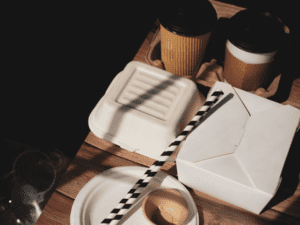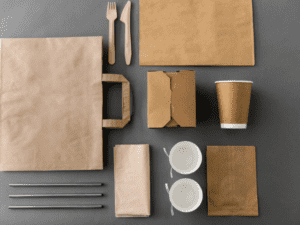Biodegradable Packaging Is A Substitute For Plastic Packaging
In the wake of escalating environmental concerns, the shift towards biodegradable packaging has gained significant momentum. A growing collective consciousness about the adverse impacts of plastic waste on our ecosystems is driving innovations in sustainable packaging alternatives.

Plastic, though prized for its versatility, durability, and convenience, has become a pervasive environmental challenge. Its non-biodegradable nature contributes to pollution, affecting both terrestrial and marine ecosystems.
Biodegradable packaging emerges as a viable and eco-friendly substitute, offering a solution that aligns with the global impetus for environmental preservation.
Crafted from materials that are easily broken down by natural processes, biodegradable packaging mitigates the issues associated with plastic waste. These materials decompose with the aid of microorganisms, returning to nature in a form that nourishes rather than depletes.
When composted, biodegradable packaging not only diverts waste from landfills but also enriches the soil, fostering a cycle of sustainability. It addresses the dual challenge of waste management and environmental conservation, marking a significant stride towards a greener, cleaner planet.
But how does biodegradable packaging stand up to its plastic counterparts, and what makes it the choice of the future? Join us as we unravel the composition, benefits, and potential of biodegradable packaging
Biodegradable Packaging Is Made From Fiber Material
Biodegradable packaging is made from materials that living organisms can break down, including paper, cardboard, plant fibers, and even some types of biodegradable plastic. This type of packaging is often used for food products, but you can also use it for other items such as cosmetics and cleaning products.
Biodegradable Packaging Is Rapidly Broken Down By Microorganisms
Biodegradable packaging is made from materials that can be broken down by living organisms such as bacteria and fungi. The term biodegradable is often used interchangeably with compostable, but there is a key difference between the two.
Compostable materials must be able to break down into nutrient-rich compost within a specific timeframe, typically within 90 days.
Biodegradable materials may take longer to break down but eventually decompose into natural elements such as carbon dioxide and water.
While biodegradable and compostable packaging is better for the environment than traditional plastic packaging, compostable packaging is more environmentally friendly. However, not all composting facilities accept compostable packaging, so it’s important to check with your local facility before using it.
Types Of Biodegradable Packaging
There are many types of biodegradable packaging, each with its advantages and disadvantages.
Paper and cardboard
Perhaps the most familiar types of biodegradable packaging. They are inexpensive to produce and can be easily recycled. However, they are not very strong and can be easily damaged.
Compostable plastics
A newer type of biodegradable packaging made from plant-based materials. They are as durable as traditional plastics but break down much faster. However, they can be more expensive than both paper and traditional plastics.
Biodegradable bags
These are usually made from cornstarch or other plant-based materials. They are strong and durable but can be more expensive than traditional plastic bags.
Each type of biodegradable packaging has its advantages and disadvantages. Paper and cardboard are inexpensive but not very durable, while plastic is more durable but takes longer to degrade.
Compostable plastics are a newer, strong, fast-degrading option, but they can be more expensive. Biodegradable bags are another good option, but they too can be pricier than traditional plastic bags. Ultimately, the best type of biodegradable packaging for a given application depends on the specific needs and budget of the user.
What Is Home Compostable Packaging?
Home compostable packaging is a type of packaging that microorganisms in a home composting system can break down. This type of packaging is made from renewable materials, such as plant-based plastics, that can be safely and easily decomposed in a home composting system.
Home compostable packaging offers a sustainable alternative to traditional, petroleum-based packaging materials, significantly reducing the amount of waste sent to landfills. In addition, home compostable packaging helps to build healthy soil and improve plant growth.
When home composted, this type of packaging reintroduces important nutrients into the soil, which helps to support a healthy ecosystem. Home composting is a simple and effective way to reduce your environmental impact and help create a more sustainable world.
How To Dispose Of Compostable Packaging?
There are many different packaging materials on the market today, and each has unique disposal requirements. One type of packaging that is becoming increasingly popular is compostable packaging. This packaging is made from natural materials that can break down into compost, making it a more eco-friendly option than traditional packaging.
So how do you dispose of compostable packaging? The first step is to check with your local waste management authority to see if they have a composting program. You can simply place your compostable packaging in the designated bin if they do. You can still compost your packaging at home if there is no composting program. Simply adding it to your regular compost bin will do the trick.
Remember, when disposing of any type of packaging, it’s important to check the labels to know how to properly dispose of it. With a little bit of care and attention, we can all do our part to reduce our impact on the environment.

Why Is It Important To Use Biodegradable Packaging?
It’s important to use biodegradable packaging because sooner or later, all packaging ends up in the environment. And when it doesn’t break down, it becomes litter.
Plastic pollution has a direct impact on human health, too. Burning plastics releases dioxins into the air, which have been linked to cancer and other health problems. And when plastic waste breaks down into small pieces, it finds its way into our food – in fact, scientists estimate that we’re eating about a credit card’s worth of micro-plastics each week.
So what can we do about all this plastic pollution? One solution is to switch to biodegradable packaging. Biodegradable packaging is made from natural materials like paper and wood that will break down naturally over time.
This means it will eventually decompose into harmless nutrient-rich compost that you can use to fertilize garden beds and grow new plants. Unlike plastic, biodegradable packaging does not threaten wildlife or human health and can even help improve the environment.
So next time you’re shopping, remember to choose biodegradable packaging whenever possible.
Wrapping Up
In conclusion, biodegradable packaging is a great way to reduce your environmental impact. It’s made from natural materials that will break down over time and doesn’t threaten wildlife or human health. So next time you’re shopping, choose biodegradable packaging whenever possible. Thanks for reading!
You can also read:
7 Eco Friendly Art Supplies To Sustain The Environment
What To Do With Stickers After Using Them?
5 Biodegradable Dog Poop Bags To Keep Your Environment Clean
10 Eco Friendly Bamboo Products for Home
